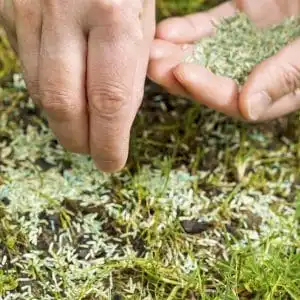Overseeding is one of the best-kept secrets for maintaining a lush, healthy lawn. Thinning grass, bare spots, and faded color are signs that your lawn may be a good candidate. But this process is time consuming and requires certain knowledge. Before you take on the task, find out more about the benefits of overseeding a lawn.
What Exactly Is Overseeding?
Overseeding a lawn is the process of planting new grass seed over previously established turf. If done proactively, it helps keep grass dense and green. If a lawn shows signs of age or suffers from bare spots or thinning, overseeding may correct it. Not to be confused with spot seeding, which targets only the areas in need, overseeding entails the entire lawn so that the healthier areas get denser and greener, while the bare or thinning spots fill out.
The Best Time to Overseed a Lawn
Your turf takes a beating in the summer months from excessive heat, drought, insects, disease, weed invasions, and increased foot traffic. The result is often a lackluster lawn. Fall is a good time to overseed a lawn because it provides the right conditions for cool season grasses like Kentucky bluegrass, ryegrass, and fescue. The air is cooler, which is good for stimulating growth, while the soil is still warm enough to enhance germination. The sunshine is less intense, making it less likely to dry out the seeds, and the rainfall provided is usually just enough.
Benefits of Overseeding a Lawn
Established lawns show signs of wear and tear after time. Chances are there are hardier grass seed varieties and blends on the market today. Integrating these new species into your lawn builds tougher turf that may be more resistant to drought, disease, and pest damage. Newer lawns benefit as well. Here are some advantages of overseeding a lawn.
- Fills in bare spots.
- Adds density to thinning lawns.
- Strengthens your turf for the harsh winter weather ahead.
- Improves the lawn’s overall health, making it stronger to withstand insects, fluctuating temperatures, pests, and weeds.
- Enhances color.
- Provides curb appeal and maintains your property value.
- Helps the lawn respond better to fertilization, irrigation, and mowing.
Knowing What Your Lawn Needs
It’s important to know why your lawn has bare spots or shows signs of thinning. For example, if you have irrigation problems or there is disease present, an overseeded lawn will succumb to these problems as well if not corrected. To find out if your lawn will benefit from overseeding, call Free Spray Lawn Care at 419-529-5296.



Comments (0)
Thanks for your comment!
Thanks for your feedback! Your comments have been successfully submitted! Please note, all comments require admin approval prior to display.
Error submitting comment!
There is a problem with your comment, please see below and try again.